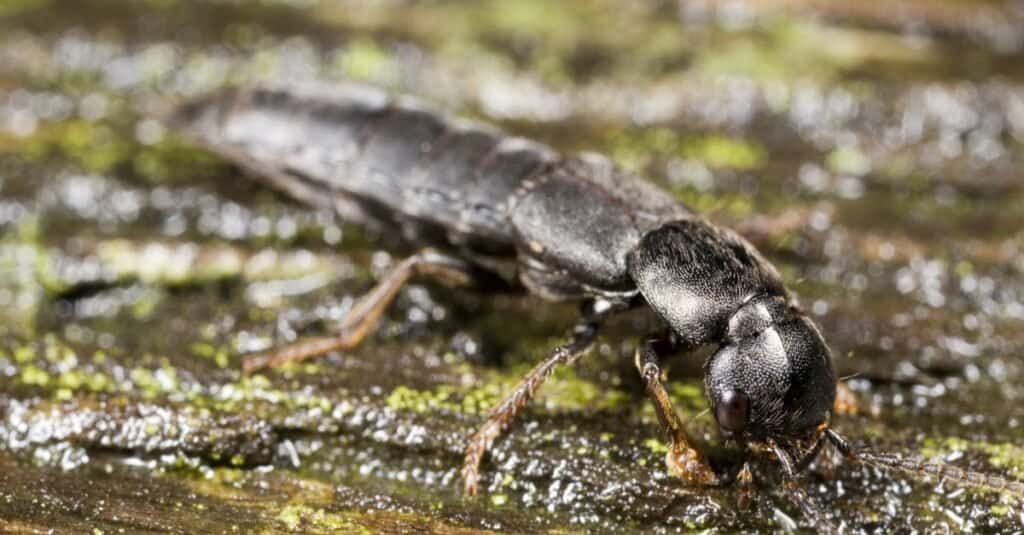Devil’s Coach Horse Beetle
Ocypus olens
The Devil’s coach horse beetle can emit a noxious substance to deter predators
Advertisement
Devil’s Coach Horse Beetle Scientific Classification
- Kingdom
- Animalia
- Phylum
- Arthropoda
- Class
- Insecta
- Order
- Coleoptera
- Family
- Staphylinidae
- Genus
- Ocypus
- Scientific Name
- Ocypus olens
Read our Complete Guide to Classification of Animals.
Devil’s Coach Horse Beetle Conservation Status
Devil’s Coach Horse Beetle Facts
- Prey
- Insects, worms, snails, and slugs
- Name Of Young
- Larvae
- Group Behavior
- Solitary
- Fun Fact
- The Devil’s coach horse beetle can emit a noxious substance to deter predators
- Biggest Threat
- None
- Most Distinctive Feature
- The long curling tail
- Other Name(s)
- Devil’s footman, devil’s coachman, devil’s steed, and cock-tail beetle
- Gestation Period
- 30 days
- Litter Size
- A single egg at a time
- Habitat
- Grasslands, farmlands, woodlands, heathlands, and gardens
- Predators
- Other insects
- Diet
- Carnivore
- Type
- Insect
- Common Name
- Devil’s Coach Horse Beetle
- Number Of Species
- 1
- Location
- Europe and North Africa, transplanted elsewhere
View all of the Devil’s Coach Horse Beetle images!
The Devil’s coach horse beetle has been associated unfairly with evil forces. In the Middle Ages, a superstition arose that the insect could curse a person just by pointing its tail in their direction.
This strange superstition has given rise to the unusual name of Devil’s coach horse beetle (which brings to mind the image of the bug drawing the coach of the devil). But despite its rather intimidating appearance (and a rather nasty bite), this insect doesn’t actually pose any real danger to people or property. This article will cover some interesting facts about the identification, habitat, diet, and lifespan of the Devil’s coach horse beetle.
Devil’s Coach Horse Beetle Species, Types, and Scientific Name
The scientific name of the Devil’s coach horse beetle is Ocypus olens. The species name olens, which means “smelling” in Latin, refers to the white stinking glands located on the abdomen. Of the 20 or so species in the genus, this species is probably the best-known and most studied. The family to which it belongs, the rove beetle, is one of the most diverse groups of animals on the planet.
Appearance: How to Identify the Devil’s Coach Horse Beetle
Identification of the Devil’s coach horse beetle should be easy because of its distinctive appearance. This species is characterized by a long segmented body with strong pincers, a rounded head, two long antennae, and a cocked or raised tail. The wing covers are short and only reach over the thorax. It also has two white glands on the abdomen to release its foul-smelling substance. The relatively long black-colored body (reaching up to 1.3 inches) can make it seem somewhat intimidating. It looks a bit like a strange combination between an ant and a scorpion, but it should not be mistaken for anything else besides a beetle. Unlike a scorpion, it has no ability to sting at all.
The entire life cycle of the Devil’s coach goes through four distinct stages. This begins with the eggs and the larva. In contrast to the grub-like appearance of many beetle larvae, the Devil’s coach larva looks a bit like a smaller version of the adult. It has a long, thin black body with multiple segments composing the abdomen and brown-colored legs. After the baby larva hatches, it passes through three distinctive molts, becoming progressively bigger each time. It spends part of the winter as a pupa, encased in its transformative shell, and emerges as an adult in the spring.

©Joseph Calev/Shutterstock.com
Habitat: Where to Find the Devil’s Coach Horse Beetle
The Devil’s coach horse beetle was originally native to Europe and northern Africa, but it was later introduced into North America, Asia, and parts of Australia as well. Adults can be found in damp moist areas such as stones or compost heaps, while the baby larvae live mostly underground. Common habitats include grasslands, forests, farmlands, heathlands, and gardens. These bugs are most active between the months of April and October. Their reproductive season normally occurs in the autumn.
Diet: What Does the Devil’s Coach Horse Beetle Eat?
The Devil’s coach horse beetle is a predatory animal. It sleeps during the day and comes out at night to stalk its prey.
What eats the Devil’s coach horse beetle?
The Devil’s coach horse beetle is preyed upon by some larger predators such as birds and mammals. There are many interesting facts about their defensive behaviors. When threatened, they curl up their tail and emit a foul-smelling substance that may disgust even a determined predator. They can also deliver a very painful bite with their mandibles, but they do not have the ability to sting.
What does the Devil’s coach horse beetle eat?
The Devil’s coach horse beetle feeds upon a variety of different snails, slugs, spiders, worms, caterpillars, woodlice, and other insects. Once it ambushes the prey with its surprising speed, the insect uses its powerful pincer-like mandibles to hold and crush the animal. The baby beetle consumes many of the same foods as the adult.
Prevention: How to Get Rid of the Devil’s Coach Horse Beetle
Despite the fact that they can bite anyone who gets too close, the Devil’s coach horse beetle isn’t generally considered to be dangerous to people. They don’t cause any real economic damage to property either. In fact, they can be a benefit to people by consuming other annoying pests. However, if they are proving to be a nuisance (they can sometimes accidentally enter the home), then you can usually get rid of them with a simple spray or trap. Make sure the spray or trap is equipped to handle this type of beetle, otherwise it may not work effectively. Fortunately, this is not a bug you would need to worry about very often.
View all 110 animals that start with DDevil’s Coach Horse Beetle FAQs (Frequently Asked Questions)
What is a Devil's coach horse beetle?
The Devil’s coach horse beetle belongs to the rove beetle family; these are defined by their long bodies and short wing covers. The name of this species came from a medieval superstition that associated it with the devil. These are not long-lived beetles. Their entire lifespan lasts about a year.
Are Devil’s coach horse beetles dangerous?
The Devil’s coach horse beetle is not necessarily dangerous to anyone. While it can deliver a painful bite, it doesn’t sting or produce venom at all. Just be aware of the fact that it may secret a foul-smelling substance if you accidentally disturb it. This smell may assault the senses, but it’s not harmful to people.
How many legs does the Devil’s coach horse beetle have?
Like all other insects, this species has six legs.
How do you identify the Devil’s coach horse beetle?
Identification of the adult is a fairly simple matter. Some of the most prominent features include the large pincers and the long segmented tail, which can curl up like a scorpion. The entire body is covered in a black or brown exoskeleton, and the head looks a bit like an ant’s. The larva looks like a thinner version of the adult.
How do you get rid of Devil’s coach horse beetles?
The Devil’s coach horse beetle can be killed with a simple spray or trap. However, unless they pose a particular annoyance, this insect should be left alone, because they’re not considered to be a pest.
Where do Devil's coach horse beetles live?
They prefer to live in secluded spots, like under moss or stones, in grasslands, forests, gardens, and other locations. They were originally native to Europe and northern Africa, but they’ve since been transplanted to North America, Asia, and Australia.
Are Devil’s coach horse beetles good for the garden?
The Devils coach horse beetle does sometimes prey upon annoying pests, but otherwise, they have a little direct effect upon a garden.
Are Devil's coach horse beetles rare?
This species is very common and widespread throughout its entire natural range. It can be found often wandering through gardens and parks.
Is a Devils’ coach horse beetle poisonous?
No, Devils coach horse beetles are not poisonous, but one of the most interesting facts is that they do secrete a foul-smelling odor from a pair of white glands at the end of the abdomen. This is a defensive measure to stop predators from eating them.
Do Devil's coach horse beetles fly?
Yes, like most other kinds of beetles, the Devil’s coach horse beetle does have a pair of wings that enable them to fly. These wings are normally covered by a hard shell on the thorax (the chest part of the body). When the insect wants to fly, it will lift up part of the thorax to reveal the wings. However, this species has evolved for life on the ground and rarely uses its wings.
What do I feed a Devil’s coach horse beetle?
This species can be fed a diet heavy on worms, snails, and insects brought from the store.
Thank you for reading! Have some feedback for us? Contact the AZ Animals editorial team.
Sources
- The Wildlife Trusts, Available here: https://www.wildlifetrusts.org/wildlife-explorer/invertebrates/beetles/devils-coach-horse
- Woodland Trust, Available here: https://www.woodlandtrust.org.uk/trees-woods-and-wildlife/animals/beetles/devils-coach-horse-beetle/

















